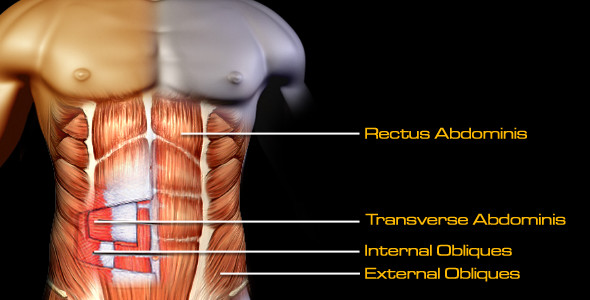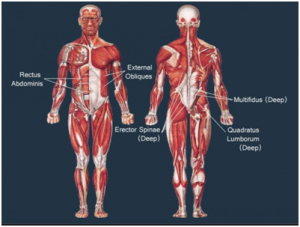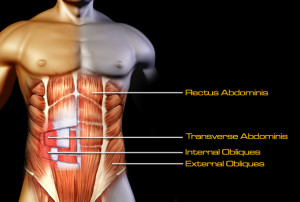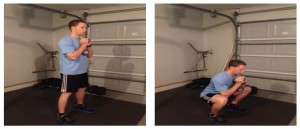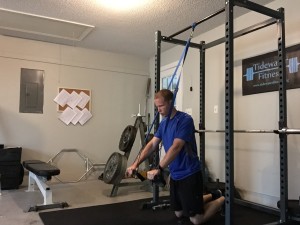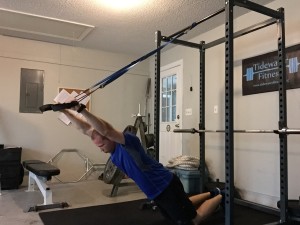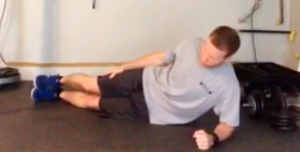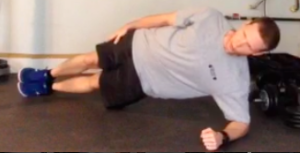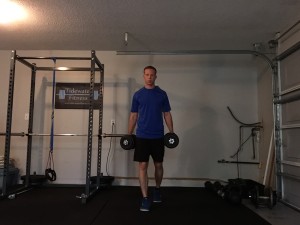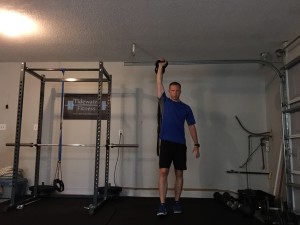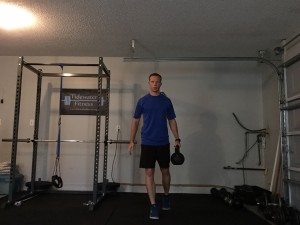Traditional core training usually consists of things like crunches, sit ups, side bends, russian twists, and the like. Walk into any commercial gym and you will be sure to see those types of exercises. These exercises allow the spine to move through a large range of motion, and do not properly train your abs.
Stuart Mcgill, a PhD in spine biomechanics, has done numerous studies and research on the spine, back pain, and performance. His research has shown your abdominals function to prevent movement rather than create it. Not only that, but repeated bending of the spine is a mechanism of injury (1).
And yet, most core training centers around movements that allow the spine to bend or rotate under load. While this may not create problems in the short-term it could down the road.
So if your abs are designed to resist movement, what’s the most effective way to train them?
Before we get into that let’s take a look at the muscles involved when training the abs and what their main functions are.
Rectus Abdominus: It flexes the trunk, but it also resists lumbar extension
Transverse Abdominus: Aids in stabilizing the trunk
Internal/External Obliques: They rotate the trunk and lateral flex the trunk, but also resist trunk rotation and lateral flexion
Quadratus Lumborum: It laterally flexes the trunk, but like the obliques it helps resist lateral trunk flexion
Multifidus: Aids in trunk extension, lateral trunk flexion, and rotation, but it also provides stabilization to the spine
Erector Spinea: Creates lumbar extension, but resists trunk flexion as well
The underlined actions are the ones I want you to pay attention to. These are key when it comes to proper abdominal training.
The primary role of your abs is to create a stable base to move from. If it isn’t stable, movement can be compromised and problems can arise. That’s why the ability to resist movement, not create it, is crucial.
I’ve talked about the definition of stability in some of my previous posts but let’s take a look at what it means in relation to the spine.
According to Stuart Mcgill, “True spine stability is achieved with balanced stiffing from the entire musculature. Focusing on a single muscle does not enhance stability but creates patterns that when quantified result in less stability .” (1)
This essentially means, all the muscles of the trunk have to contract simultaneously to provide rigidity and stiffness to the the spine. This is what allows us to move safely and efficiently.
Mcgill goes on to say “spine stability requires the musculature be cocontracted for substantial durations but at relatively low levels of contraction. This is a endurance and motor control challenge.” (2) On a side note, many people have back pain because they use their backs for everything (lifting, walking, getting up) and do not have great endurance of the trunk musculature.
With traditional ab exercises, the abdominal muscles are shortened over and over again. This doesn’t happen in everyday life though. There isn’t a need for it.
What actually happens is the abdominal muscles contract at the same time so you can perform a certain task. Think about when you move a heavy piece of furniture. You normally take a breath in, contract your abs (brace), and pick it up. That’s spinal stability in action.
If this is the way our abdominals function in everyday life, shouldn’t we train them like this as well?
With that in mind, I want to outline a better way to train your abs. This isn’t new by any means, but most people don’t know this information.
There are four main categories of exercises. Remember, the abs can resist trunk flexion, trunk extension, lateral trunk flexion, and rotation. So this is how we will categorize them:
- Anti-flexion
- Anti-extension
- Anti-lateral flexion
- Anti-rotation
But I want to add one more into the mix, loaded carries. So the list will now look like this:
- Anti-flexion
- Anti-extension
- Anti-lateral flexion
- Anti-rotation
- Loaded carries
Let’s take a look at some exercises in each of these categories.
Anti-flexion: Squat
Though the squat isn’t a direct core exercise it indirectly trains the core. With a goblet squat, your erector spinea has to resist trunk flexion so you don’t fall forward.
Anti-extension: Fallout
This is a great exercise to train the rectus abdominus. As you move forward, your low back will want to arch, but you have to prevent this from happening. The spine must stay in a neutral position.
Anti-lateral flexion: Side Bridge
To effectively train the obliques and quadratus lumborum you need to resist lateral flexion. This is where the side bridge fits in nicely. As you hold the bridged position, the goal here is to not let your hips drop.
Anti-rotation: Pallof press
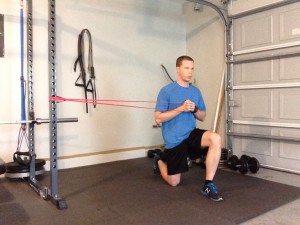
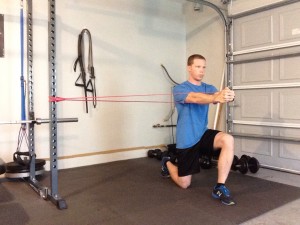
This is one of my favorite exercises for the internal and external obliques. When you press the band out, you will feel it wanting to rotate your body. Your obliques have to work hard to prevent this from happening.
Loaded carries: Farmer’s carry, Suitcase carry, Waiters walk
A loaded carry is one of the most “functional” exercises there is. In life, we are constantly picking up things to move them somewhere else (groceries, children, furniture, etc.). With a loaded carry, the goal is simple: walk a certain distance while keeping the abs braced, an upright posture, and a neutral spine.
There is also a lot a variety with carries. With the farmer’s carry, you have to resist trunk flexion. With the suitcase carry you resist lateral trunk flexion and rotation. In the waiter’s walk, you resist lateral trunk flexion, rotation, and lumbar extension. There are many more carry variations out there, but these give you a great foundation.
How to add these into your own training?
Many people perform some type of squat or plank in their program already. So I would argue anti-lateral flexion, anti-rotation, and loaded carries need to be more often than the previous two.
The easiest thing to do is to take an exercise from each category and place it into one of your training days. So let’s say you hit the gym Mon/Wed/Fri, you could add anti-lateral flexion on Monday, anti-rotation on Wednesday, and loaded carries on Friday.
If you train more than three days add another category. If you train three days or less, cycle through each category. For example if training two times per week, one month would be dedicated to anti-lateral flexion and anti-rotation then the next could be anti-extension and loaded carries.
As far as reps go, start in the 6-10 rep range for all the anti-movement exercises (6-10 breaths on each side for the side bridge and pallof press). With the loaded carries, you can either go a certain distance (i.e. 50 yds or 50 steps) or a certain time. The most important thing is to make sure you are doing them correctly.
Wrapping Up
Proper core training is more about resisting movement rather than isolating one muscle. Your abdominals function together to create seamless movement. And that’s how they should be trained, together. Make sure to include these types of exercises in your training regimen and you will be all set!
References:
1. https://www.nsca.com/uploadedFiles/NSCA/Resources/PDF/Education/Articles/NSCA_Classics_PDFs/Core%20Training%20Evidence%20Translating%20to%20Better.pdf
2. http://www.backfitpro.com/pdf/selecting_back_exercises.pdf
Photo credit:
1. http://runjersey.com/six-pack-abs-for-runners/
2. http://sprintmalta.com/core-stability/

